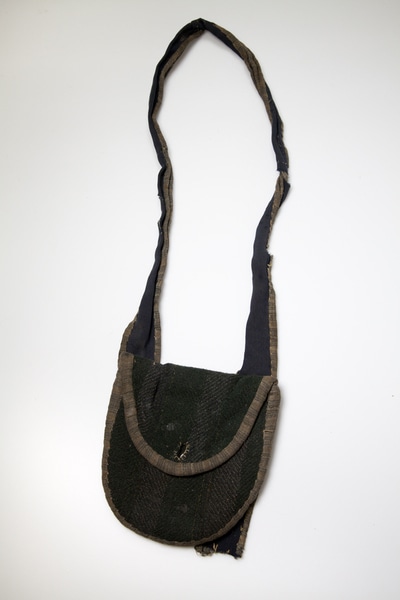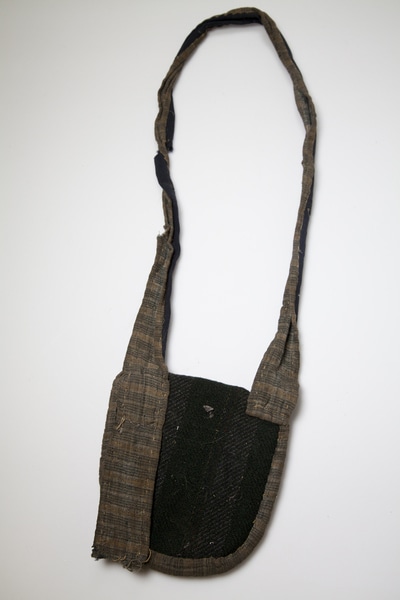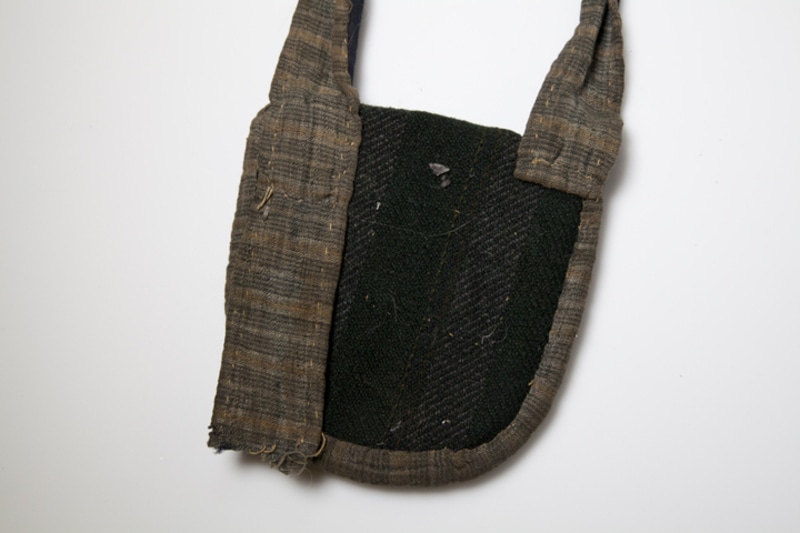shot pouch Item Number: 1927.1734 . 176350 from the The Field Museum




Citations From Vanstone (1982) Article
« Before the acquisition of breech-loading firearms, the Montagnais-Naskapi, like other Indians, used muzzle-loading percussion guns. These required the carrying of shot pouches, of which there are are five in the Speck collection. The size of the shot pouch was determined by the size of a hunter's fist, since he would be reaching in for a hand-full of shot (Speck, 1935, p. 213).
Two pouches, both of which appear to have seen considerable use, are made of black wool felt, the seams being bound with cotton tape. Buttons are provided to fasten the flaps. One pouch, from Kiskisink, has a shoulder strap of the same material as the pouch (fig. 20b) [...]. »
Vanstone, James W. "The Speck Collection of Montagnais Material Culture from the Lower St. Lawrence Drainage, Quebec." Fieldiana. Anthropology. New Series, No. 5 (October 29, 1982), p.11, fig 20b (p.48).
« Speck (1935, pp. 213-215) notes that the period during which shot pouches were used most extensively corresponded with the availability, at posts of the Hudson's Bay Company, of beads and a variety of cloth fabric of different colors. Thus the pouches, which were made by women, became one of the most important vehicles for Montagnais artistic expression. As with other decorated objects made and used by these Indians, the designs on shot pouches served as the means by which the spirits of individual owners achieved control over game animals. »
Vanstone, James W. "The Speck Collection of Montagnais Material Culture from the Lower St. Lawrence Drainage, Quebec." Fieldiana. Anthropology. New Series, No. 5 (October 29, 1982), p.11.
Translation Of Citations From Vanstone (1982) Article
« Avant l’acquisition d’armes à chargement par la culasse, les Montagnais-Naskapi, comme les autres Indiens, utilisaient des armes à percussion à chargement à museau. Cela nécessitait le transport d’étuis à munitions, on en retrouve cinq dans la collection de Speck. La dimension des étuis à munitions était déterminée par la dimension du poignet du chasseur, puisqu’il devait atteindre l’intérieur pour prendre une poignée de munitions (Speck, 1935, p. 213).
Deux étuis semblent avoir été considérablement utilisés, et sont faits de feutre de laine noire, la couture étant attachée avec du ruban de coton. Les boutons permettent d’attacher le rabat. Un étui, de Kiskisink, comporte une sangle pour l’épaule qui est fait du même matériel que l’étui (fig. 20b) [...]. »
Vanstone, James W. "The Speck Collection of Montagnais Material Culture from the Lower St. Lawrence Drainage, Quebec." Fieldiana. Anthropology. New Series, No. 5 (October 29, 1982), p.11, fig 20b (p.48).
« Speck (1935, pp. 213-215) a noté que la période pendant laquelle les étuis à munitions étaient le plus utilisés correspond au moment où la disponibilité des perles et une variété de matériaux en tissus de différentes couleurs étaient disponibles aux postes de la Compagnie de la Baie d’Hudson. Ainsi, les étuis, qui étaient fabriqués par les femmes, sont devenus l’un des moyens les plus importants d’expression artistique pour les Montagnais. Comme d’autres objets décorés faits et utilisés par ces Indiens, les motifs sur les étuis à munitions servaient de moyen pour l’esprit de l’individu qui en était propriétaire à obtenir le contrôle sur les animaux chassés. »
Vanstone, James W. "The Speck Collection of Montagnais Material Culture from the Lower St. Lawrence Drainage, Quebec." Fieldiana. Anthropology. New Series, No. 5 (October 29, 1982), p.11.
Item History
- Made in Pekuakami, Lac Saint-Jean, Lake St. John, Labrador, Canada
What
- Name
- shot pouch
- Identification Number
- 1927.1734 . 176350
- Type of Item
- shot pouch
- Material
- “dark green cloth; straps of grey cloth” ?
Who
- Culture
- Ilnu, Montagnais and Innu
Where
- Holding Institution
- The Field Museum
- Made in
- Pekuakami, Lac Saint-Jean, Lake St. John, Labrador, Canada
Other
- Nom De L'objet
- Étui à munitions
- Matériaux
- tissu vert foncé; bandoulières en tissu gris
- Ethnic Group
- Montagnais
- Collection
- Lake St. John Objects
- Provenience
- North America, Canada, Quebec, Labrador, Lake St. John